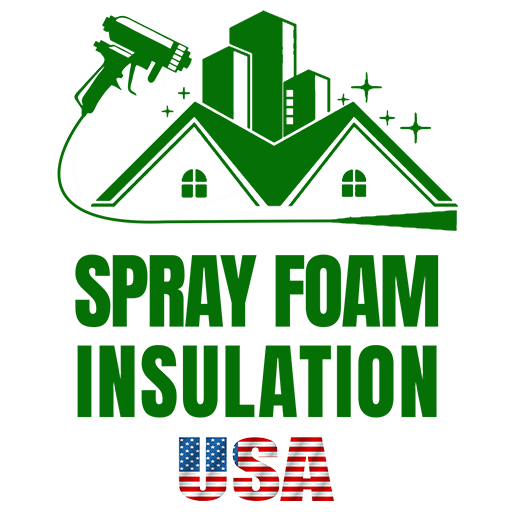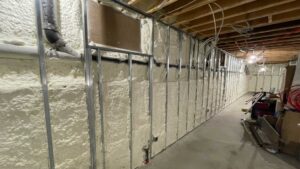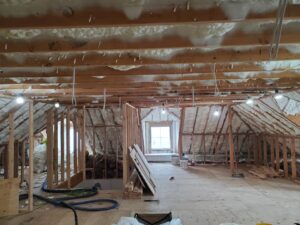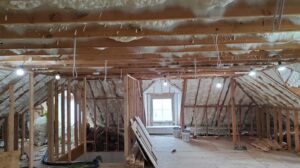Quick Guide to Acoustic Insulation Solutions:
– Soundproofing vs. Sound Absorption: Soundproofing blocks sound from entering or leaving a space, while sound absorption reduces echo within a room.
– Ideal Materials: For optimal sound insulation, materials like mineral wool, fiberglass, and acoustic foam are highly effective.
– Key Areas: Focus on walls, ceilings, and floors for comprehensive sound insulation.
– DIY Tips: Simple solutions include using sound mats under floors and sealing gaps with acoustic caulk.
In today’s bustling world, the clamor of urban environments can encroach upon our peace within the sanctum of our homes and offices. However, acoustic insulation offers a bastion against this tide of noise. Understanding the principles of acoustics and the importance of sound insulation is crucial for anyone seeking to create a tranquil space.
Sound travels in waves, penetrating the fabric of our buildings and disturbing our quietude. Not all noises are unwelcome, but the intrusion of traffic, construction, and even loud conversations can disrupt our living and working environments. This is where acoustic insulation steps in as a hero, providing the tools we need to mitigate these disturbances.
Acoustic insulation works on two fronts: soundproofing and sound absorption. Soundproofing is about blocking sound from entering or leaving a space, while sound absorption focuses on reducing the echo and reverberation within a room itself. Materials play a key role here, with some, like mineral wool and fiberglass, being exceptionally good at keeping your conversations in and the world’s noise out.
The tranquility of your space translates directly to improved mental health and productivity. Whether it’s the gentle hum of a well-insulated office space or the peaceful silence of a home, the mental and physical benefits of a sound-managed environment are profound. By addressing sound at its source and managing how it moves through spaces, we can significantly enhance the quality of our indoor environments.
Understanding Acoustic Insulation
When we talk about making our homes or offices quieter, we’re diving into acoustic insulation. This can get a bit technical, but stick with me—I’ll make it as simple as a peanut butter and jelly sandwich.
Soundproofing vs. Sound Absorption
First off, soundproofing and sound absorption are like two peas in a pod, but they’re not the same pea. Soundproofing means stopping sound from getting in or out of a space. Think of it as building a fortress around your quiet. On the flip side, sound absorption is about making the sound inside a room less echoey and sharp. It’s like turning your room into a giant sponge that soaks up sound.
Transmission Loss
Next up, let’s chat about transmission loss. This is a fancy term for how much a material can block sound from passing through it. The higher the transmission loss, the better the material is at keeping your secrets (or just your loud music) from escaping through the walls. Materials like mineral wool and mass loaded vinyl are the superheroes of transmission loss.
Noise Reduction Coefficient
Lastly, we’ve got the Noise Reduction Coefficient (NRC). This measures how well materials can absorb sound. It’s a number between 0 and 1. Closer to 1 means the material loves to gobble up sound, making it great for sound absorption. Materials like acoustic foam and fiberglass often have high NRC values, making them your go-to for turning down the volume on echoes and reverberations inside a room.
Understanding these concepts helps you make informed decisions when choosing acoustic insulation solutions. Whether you’re battling noisy neighbors or trying to create the perfect home cinema experience, knowing your soundproofing from your sound absorption, and the importance of transmission loss and NRC, can guide you to a quieter life.
In our next section, we’ll dive into the Best Materials for Acoustic Insulation, putting our newfound knowledge to good use. Stay tuned to learn about the materials that will help you achieve acoustic bliss in your space.
Best Materials for Acoustic Insulation
When it comes to creating a serene and noise-free environment in your home or office, choosing the right materials for acoustic insulation is crucial. Let’s explore some of the top contenders that can help you achieve acoustic bliss.
Mineral Wool
Mineral wool, including rock and slag wool, is a heavyweight in acoustic insulation. It’s known for its excellent sound absorption capabilities and fire resistance. Mineral wool can significantly reduce noise transmission between rooms and from the outside. It’s dense, which makes it great at trapping sound waves and preventing them from bouncing around your space.
Fiberglass
Fiberglass is another popular choice for acoustic insulation. It’s made from fine glass fibers and is especially effective at absorbing high-frequency sounds. This makes it an ideal option for offices and homes located in busy urban areas where blocking out external noise is essential. Fiberglass insulation is also energy efficient, helping to keep your space warm in the winter and cool in the summer.
Cotton
Cotton insulation, often made from recycled denim, is a green and sustainable option. It’s not just soft to the touch but also excellent at reducing noise. Cotton has natural sound-absorbing properties, making it perfect for use in walls, floors, and ceilings to create a quieter living or working environment. Plus, it’s safe to handle and install, with no itchy fibers or harmful chemicals.
Foam
Foam insulation, including products like AP ArmaFlex® and AP CoilFlex®, offers both thermal and acoustic benefits. These foams are designed to minimize structure-borne and airborne noise, making your HVAC and plumbing systems whisper-quiet. The closed-cell structure of these foams makes them excellent at dampening vibrations and absorbing sound, ensuring that your space remains undisturbed by unwanted noise.
Polypropylene
Polypropylene is a lesser-known but effective acoustic insulation material. It’s lightweight and can be used in acoustic panels and underlays for floors. Polypropylene is particularly good at reducing impact noise, making it a smart choice for high-traffic areas or in buildings where footfall noise can be a problem.
Choosing the Right Material
Selecting the right material for your acoustic insulation project depends on several factors, including the type of noise you’re dealing with (airborne or impact), the area you’re insulating (walls, floors, ceilings), and your budget. Here’s a quick guide to help you make an informed decision:
- For High-Frequency Noise: Fiberglass or mineral wool.
- For Impact Noise: Polypropylene or foam underlays.
- For General Sound Absorption: Cotton or mineral wool.
- For HVAC and Plumbing Noise: Foam products like AP ArmaFlex®.
The effectiveness of acoustic insulation also depends on proper installation. Ensure that materials are correctly fitted and sealed to maximize their soundproofing capabilities.
By choosing the right materials and ensuring they’re properly installed, you can significantly improve the acoustic comfort of your space. Whether you’re looking to create a peaceful home environment or a productive office space, these materials offer solutions to meet a variety of acoustic insulation needs.
In the next section, we’ll explore Effective Acoustic Insulation Solutions for different parts of your building, providing practical advice on how to implement these materials for the best results. Stay tuned to learn how to turn your space into a haven of tranquility.
Effective Acoustic Insulation Solutions
Creating a quiet, comfortable space involves more than just adding a few panels here and there. It’s about understanding the science of sound and using the right materials in the right places. Let’s dive into some effective solutions for different parts of your home or office.
Walls and Ceilings
- Green Glue: This is a noiseproofing compound that can significantly reduce sound transmission between rooms. It’s easy to use; simply apply it between two layers of drywall to dampen vibrations. A great choice for music rooms or home theaters.
- Sound Isolation Clips: These are a game-changer for reducing sound transfer through walls and ceilings. By decoupling the drywall from the structure, these clips help to isolate sound waves, making your space quieter.
- Mass Loaded Vinyl (MLV): This dense material blocks sound from entering or leaving a room. It’s thin and flexible, making it easy to install on walls, ceilings, and even around ductwork.
Floors
- Iso-Step®: Placed under your flooring, this underlayment can reduce impact noise and airborne sound, making it ideal for apartments or multi-story buildings.
- Underlayment: A good underlayment can make a big difference in sound reduction, especially for hard flooring surfaces. It adds a layer of sound dampening that helps to absorb footfalls and other impact noises.
- Mass Loaded Vinyl: Just like for walls and ceilings, MLV can be used on floors to block sound transmission. It’s particularly effective when used under carpet or engineered hardwood.
HVAC and Plumbing Systems
- AP ArmaFlex®: This elastomeric foam insulation is designed for HVAC systems, reducing both airborne and structure-borne noise. It’s a smart choice for minimizing the sound of air flowing through ducts.
- AP CoilFlex®: Specifically designed for HVAC coils, this conformable foam helps to reduce vibrations and noise within your HVAC system, making your environment more comfortable.
- Dampening Vibrations: Using materials like ArmaFlex foam around pipes and ductwork can significantly reduce the noise generated by water and air movement.
DIY Solutions
- Acoustical Panel Materials: For those who love a good DIY project, creating custom acoustic panels can be a rewarding way to improve your space’s acoustics. Using materials like fiberglass or stone wool insulation as a core, you can tailor the size, shape, and color to fit your needs.
- DIY Wall Panels and Bass Traps: With some basic materials and a bit of elbow grease, you can build your own wall panels and bass traps. These can be strategically placed to absorb sound where it’s most needed, like in corners or near speakers.
- Bass Traps: Low-frequency sounds can be particularly hard to manage. DIY bass traps placed in corners can help to absorb these stubborn sound waves, making your audio experience clearer and more pleasant.
Implementing these solutions can transform a noisy, distracting environment into a peaceful, productive space. Whether you’re looking to improve the acoustics of a home office, a professional recording studio, or simply want a quieter living area, there’s an acoustic insulation solution that can help. The key to success lies in choosing the right materials and placing them thoughtfully throughout your space. With a little effort and the right approach, you can achieve a significantly quieter and more enjoyable environment.
Acoustic Insulation Products Overview
When it comes to improving the acoustic quality of your space, whether it’s for a home office, a cozy living room, or a professional recording studio, choosing the right products is crucial. Let’s dive into some of the top acoustic insulation solutions that can transform your environment into a serene and sound-controlled sanctuary.
AlphaSorb
AlphaSorb® products are a fantastic choice for those looking to enhance the acoustic aesthetics of their space. These fabric-wrapped acoustic panels not only absorb unwanted sound but also add a touch of style. Available in various sizes and colors, AlphaSorb® panels can be easily integrated into any design scheme, making them perfect for offices, home theaters, and commercial spaces aiming for a modern look without compromising on sound quality.
PrivacyShield
For those needing to tackle the challenge of sound leakage, PrivacyShield® products offer an effective solution. The PrivacyShield® Plenum Return Silencer G2, for instance, is designed to reduce sound transmission through air ducts, ensuring that private conversations stay private. This is particularly useful in office settings where confidentiality is key.
AudioSeal
AudioSeal® Mass Loaded Vinyl (MLV) is a soundproofing barrier that blocks sound from entering or leaving a space. Its versatility allows it to be used in walls, ceilings, and floors, making it an all-around solution for creating a quiet environment. Whether you’re dealing with noisy neighbors or loud street traffic, AudioSeal® can provide the peace you need.
Whisperwave
Whisperwave® Ceiling Clouds are not only visually striking but also highly effective at reducing noise and echo within a room. These wave-patterned panels can be suspended from ceilings, offering a unique aesthetic while significantly improving speech intelligibility and overall sound quality. They are particularly useful in spaces with high ceilings, such as auditoriums and open-layout offices.
Green Glue
Last but not least, Green Glue Noiseproofing Compound is a game-changer for those looking to soundproof a space without major renovations. This compound can be applied between layers of drywall to dampen vibrations and reduce sound transmission. It’s an easy DIY solution that can make a noticeable difference in reducing noise levels, ideal for home theaters, music rooms, and any space where sound quality matters.
Each of these products offers a unique set of benefits tailored to different acoustic challenges. Whether you’re looking to absorb sound, block it, or both, there’s an option that can meet your needs. The effectiveness of these solutions depends not only on the product itself but also on proper installation and the specific requirements of your space. With the right approach and the best acoustic insulation products, you can create an environment that sounds just as good as it looks.
Frequently Asked Questions about Acoustic Insulation
When it comes to making your home or office quieter and more comfortable, understanding acoustic insulation is key. Here are some of the most common questions we get, along with straightforward answers to help you make informed decisions.
What insulation is best for acoustics?
The best insulation for acoustics varies depending on your specific needs, but mineral wool, Rockwool Flexi, and Earthwool are top contenders. These materials are dense and fibrous, making them excellent at absorbing sound. They can significantly reduce noise transfer between rooms and from outside sources, making your space quieter and more serene.
- Mineral wool is known for its high density and ability to absorb sound waves.
- Rockwool Flexi offers flexibility and ease of installation, fitting snugly between wall studs without sagging.
- Earthwool is a more eco-friendly option, made from recycled materials and providing excellent sound absorption.
Does acoustic foam really work?
Yes, acoustic foam works well for sound treatment, especially in spaces like home studios or entertainment rooms. It’s designed to reduce echo and reverberation, improving the quality of sound within a room. However, it’s important to note that acoustic foam is more about improving sound quality rather than blocking sound transmission. If your goal is to prevent sound from entering or leaving a room, other solutions might be more effective.
What is the best insulation for soundproofing?
For true soundproofing, you’ll want to look at materials like mineral wool, rock wool, and fiberglass. These materials have the density and mass needed to block sound from passing through walls, floors, and ceilings.
- Mineral wool and rock wool are similar in composition and effectiveness, both offering excellent sound-blocking capabilities.
- Fiberglass, while also effective, may require more material to achieve the same level of soundproofing as mineral or rock wool.
Sound treatment vs. Soundproofing
It’s crucial to understand the difference between sound treatment and soundproofing:
- Sound treatment focuses on improving the acoustic quality within a room by absorbing excess sound and reducing echo.
- Soundproofing aims to prevent sound from entering or leaving a space, requiring materials that block sound transmission.
By choosing the right type of insulation for your needs and ensuring it’s properly installed, you can significantly improve the acoustic comfort of your home or office. Whether you’re looking to create a quiet study space, a peaceful bedroom, or a professional-sounding recording studio, there are acoustic insulation solutions that can help you achieve your goals.
Conclusion
In wrapping up our guide to acoustic insulation for your home or office, it’s clear that the journey towards a quieter, more peaceful environment is within reach with the right solutions. At Spray Foam Insulation USA, we’re committed to providing you with top-tier acoustic insulation solutions that not only meet your soundproofing needs but also align with eco-friendly and sustainable practices.
Eco-friendly Solutions: We understand the importance of protecting our planet while enhancing our living spaces. That’s why our acoustic insulation solutions are designed with sustainability in mind. From using materials that have a lower environmental impact to employing methods that reduce energy consumption, we ensure that our products contribute to a healthier environment.
Sustainable Insulation: Our commitment to sustainability doesn’t stop at the materials we use. The very nature of our spray foam insulation offers a dual benefit—it not only provides superior soundproofing capabilities but also enhances the energy efficiency of your home or office. This means lower energy bills and a smaller carbon footprint, making it a win-win for you and the planet.
Choosing Spray Foam Insulation USA for your acoustic insulation needs means opting for a solution that respects the environment while offering the peace and quiet you deserve. Our expert team is dedicated to helping you select the right insulation for your specific needs and ensuring it’s installed to perfection.
Let us help you transform your space into a sanctuary of silence and comfort, all while contributing to a greener, more sustainable world. Discover the advantages of choosing us for your insulation needs and take the next step towards a more serene and eco-friendly living or working environment.
Explore the advantages of choosing Spray Foam Insulation USA for your insulation needs.
Every step we take towards better insulation is a step towards a healthier planet. By opting for sustainable and eco-friendly acoustic insulation solutions, we’re not just improving our immediate surroundings; we’re contributing to a global effort to protect our environment for future generations. Let’s build a quieter, greener world together, one insulated space at a time.





